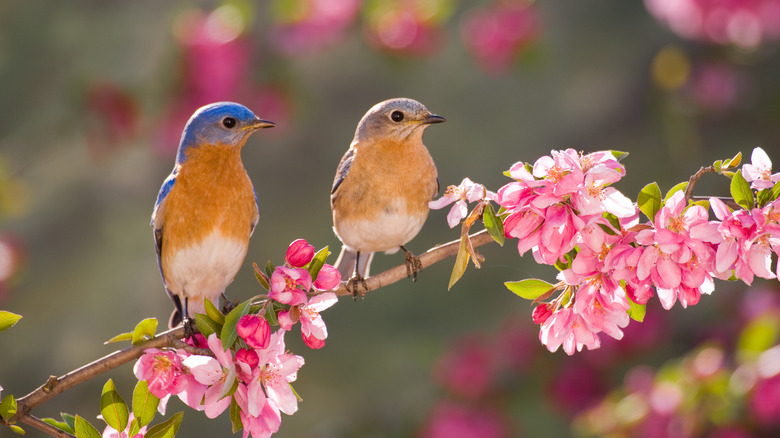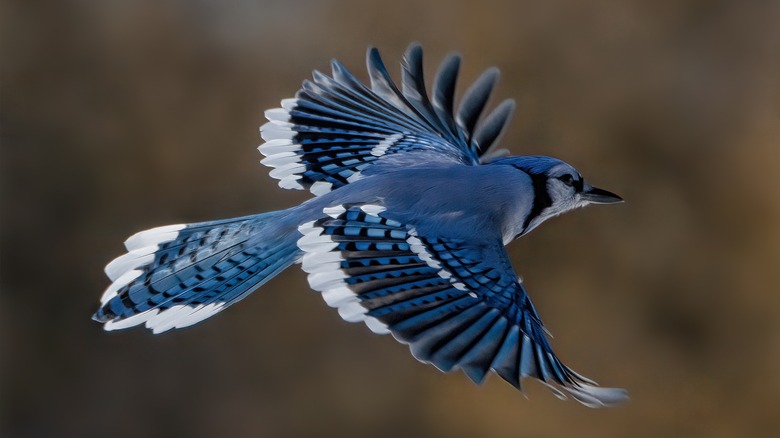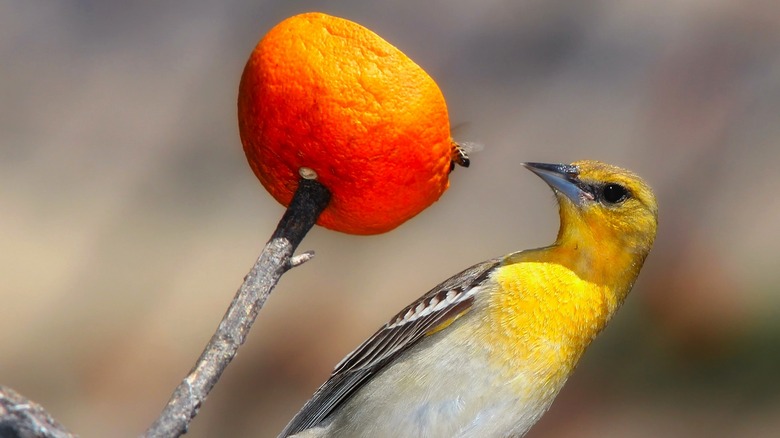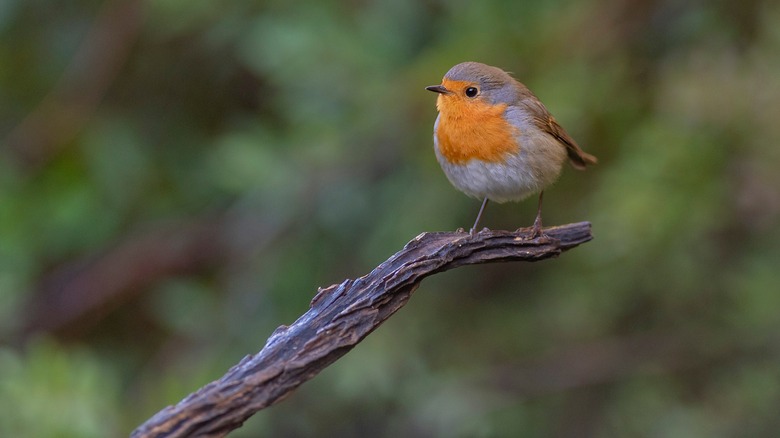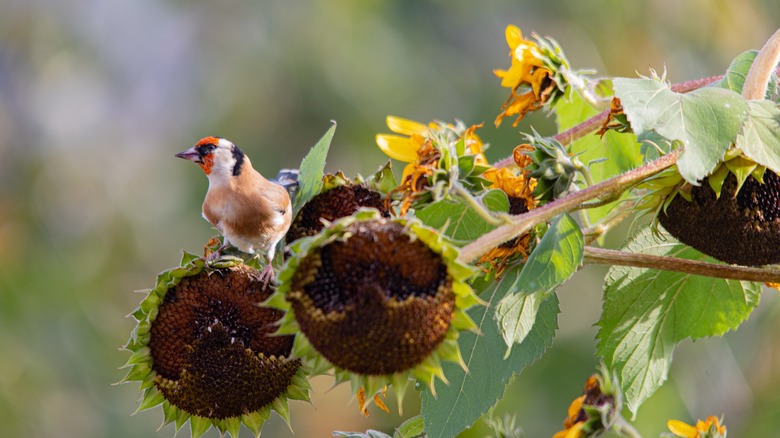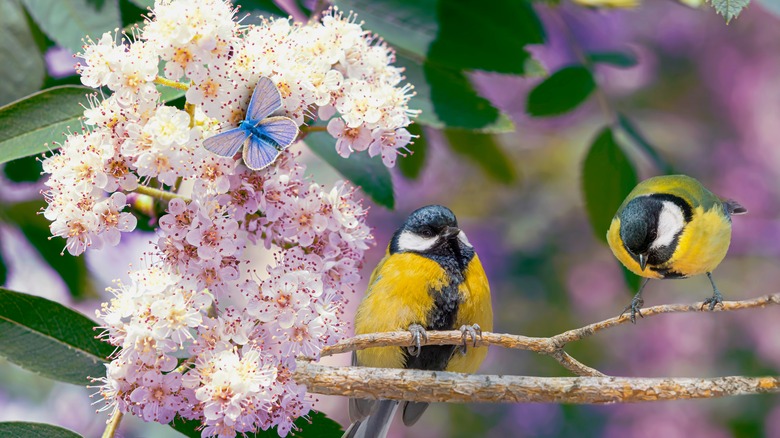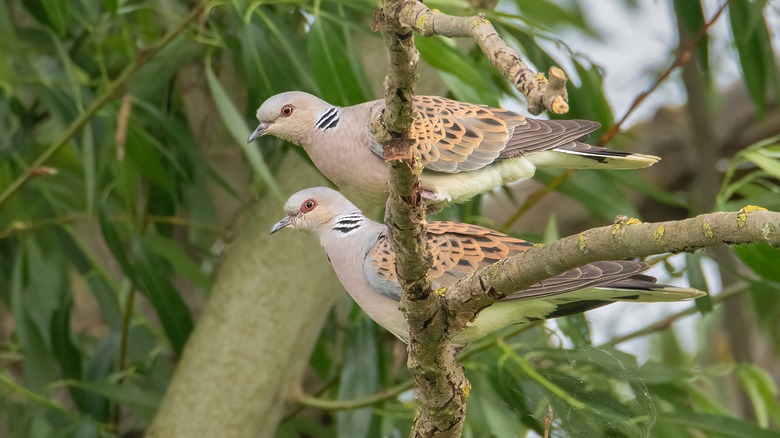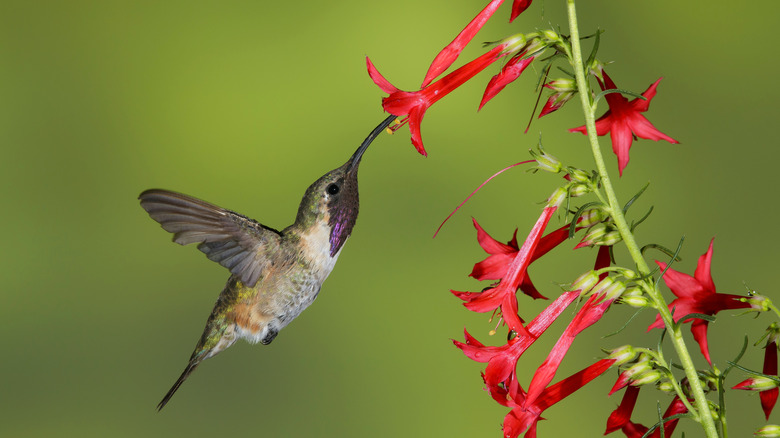7 Colors That Will Attract More Birds To Your Garden
Birds are magnificent creatures for many reasons, including their razor sharp eye sight. Because birds respond to bright colors like humans do, scientists long assumed that they process the color spectra in a similar way. But birds can actually see UV light, which humans can't, and color plays a role in everything in their life, from where they choose to nest to who they pick as a mate. There are certain colors that have been observed to attract different species of birds. This usually has to do with their ability to camouflage, the color of food in their native region, or the color of nectar-rich flowers they feed on.
Integrating certain vibrant colors into your garden can help increase the number of birds who make the space their home, but if these colors clash with your design aesthetic, rest assured that neutrals and earthy tones can also be effective, since they blend into the environment and appeal to a bird's need for camouflage. One color to avoid? White. This color creates a sharp contrast against the surrounding environment, and it is thought that white signals a warning or perceived threat to birds. So, whether you want to increase your overall bird population or attract your favorite winged friend to your home, here are seven colors that will have the birds flocking.
Blue for blue jays and bluebirds
The name says it all: Blue jays and bluebirds seem to be attracted to their own color. While the color blue is beautiful, this isn't purely narcissistic. Their color preference could be due to many factors, but is most likely because it provides a camouflage environment that the birds can use to remain safe and hidden from any lurking predators.
By planting some blue flowers, you will not only create a welcoming environment for the birds, but also a beautiful, vibrant landscape for you to enjoy. Blue varieties of perennials, or the obvious choice of bluebells, will add a cool-toned pop to your yard, which will stand out against any other green foliage. You can also integrate the color blue into your birdhouse design. If you don't want to go overboard and have your backyard looking like a Smurf village, you can buy or make one with a quaint blue roof, like this option from Amazon. This will have the color capture the bird's attention from the skies, while looking subtle in your yard.
Orange for orioles
Is your favorite part of the year when citrus comes into season and you can indulge in a juicy orange? If so, orioles would agree. These birds love oranges more than anything, and many oriole-specific feeders have places designed to put citrus slices. When they see the color orange, they associate it with their favorite food and will fly down to get a closer look. Beyond thinking with their stomachs, these birds have bright orange plumage, which makes them eye-catching to predators. When they can blend themselves into an orange surrounding, it makes it easier to camouflage, which increases their chance of survival.
Planting an orange tree in your backyard would be a surefire way to be an oriole's favorite place on the block, but for something less committal, you can buy an orange bird feeder. This Perky-Pet feeder from Amazon features a bright orange base, as well as a jelly cup attachment and fruit slice spikes to make this the most attractive option for nearby orioles. Planting some striking orange flowers will also create a cheerful environment that will make the brightly-colored birds feel at home. Marigolds in particular are easy to grow from seeds and can last in high temperatures, making sure they stay in bloom all through summer.
Black for robins
Great news for lovers of minimalist design: Robins are more likely to visit a black bird feeder over any other bright color. The research on why they prefer this color is still inconclusive, but if you want to attract robins, then using black is the right choice for you. The darkness doesn't seem to bother them, as robins are one of the most light-sensitive bird species and have been shown to prefer to sing at night in light polluted urban areas.
Integrating a black birdhouse, like this one from 2Modern, will provide a safe shelter for robins, while seamlessly blending into the environment. This is good for aesthetics, but also for the birds themselves, since the camouflage means that they are less visible to any potential predators. This makes them feel safer and therefore more attracted to your garden. While you probably won't find any black flowers naturally growing at the garden center, you can use other decorations like flower pots to integrate black into your yard.
Yellow for goldfinches and cardinals
Yellow is one of the happiest colors for humans and birds alike, and integrating it into your yard can attract a variety of birds, from those with yellow plumage to nocturnal species. Goldfinches love yellow, because as eye-catching as their plumage is to humans, it is equally as eye-catching to predators. The yellow environment will allow them to blend in and have a greater defense against threats.
Seed eaters like cardinals will also flock to the color yellow since it is associated with sunflowers. For a bird, the hundreds of seeds inside a sunflower is like the best buffet in town, and the distinct yellow petals make them easy to spot. Because yellow is so easy to see at nighttime compared to other deep colors (like red), species that are most active during dawn or dusk (such as nightjars) will also be most drawn to yellow simply because that is what they can see.
Planting some sunflowers in your yard is a great way to integrate yellow, but there are also many other yellow flowers that can thrive in your garden environment. These yellow flowers are often the favorites of bees and butterflies as well, making your home into a true sanctuary for all springtime critters. Of course, you can also hang up a classic yellow birdhouse or go for a more whimsical decoration with this beehive shaped one from Joann.
Pink and purple for chickadees
It might not be Valentine's Day, but pink and purple are still a winning color combination. Many types of flowers bloom in this color palette and are a fan-favorites for evoking a whimsical, English-style garden vibes. They also provide a pop of color amid green foliage. Chickadees and woodpeckers seem to be especially attracted to this color. While we don't know for sure why these little songbirds favor pink and purple, we do know that, in addition to insects, they also like to eat berries and fruit. It's possible they associate the bright pink and purple colors with the hue of berries that would be found in the wild, though this hasn't been proven.
Purple coneflowers have been known to attract birds and can be easy to grow in your yard. You can also integrate the color into your birdhouse. Pink store-bought ones are available, like this one with a floral design from Etsy, but you can also create a DIY birdhouse and paint it any color you like. Just remember to always use non-toxic paint, so you don't build a house that inadvertently harms the creatures flocking to it.
Green for blackbirds and doves
It's likely that you already have lots of green plants in your yard, which means you've already created an attractive environment for blackbirds, doves, and other species of birds. Green is the universal color of safety for these birds. It signals an area that is good to take shelter and stay hidden from predators.
There are an overwhelming amount of options for green plants, so if you want to attract blackbirds and doves to your yard, you can try branching out — literally. Think beyond flowers and find ways to integrate some beautiful bushes to provide structure to your yard. Or, if you are planning on repainting a deck or shed, consider the our 2023 color of the year, Teresa's Green by Farrow & Ball. This is a relaxed green, as opposed to a deeper green that we often see in nature-inspired collections, that will create a calming, coastal aesthetic for you, while also evoking that sense of safety for the birds.
Red for hummingbirds
Hummingbirds are unlike any other type of bird in the world. They flap their wings up to 70 times per second and their heart pumps at 1,200 beats per minute! These zippy creatures deserve a welcoming place to stop and relax, and you can create an attractive hummingbird rest stop by using the color red. They love red flowers, which typically contain a lot of nectar for them to eat, but they are also attracted to the color because of the unique way the cones in their eyes process light. According to the National Audubon Society, "The cones themselves contain pigments and oil droplets in shades of yellow to red, which seem to act like filters. The filters appear to heighten color sensitivity in the red to yellow range, while muting colors such as blue."
This means that they prefer red because it is one of the colors they see most clearly. Leaving out a red hummingbird feeder is one of the most popular options, as it is proven to work! This is a very simple way to attract more hummers because it doesn't require you to change your landscaping, but if you are willing to integrate a new plant, a bull thistle is the way to go. This is equivalent to a hummingbird's favorite restaurant due to the plant's large amount of pollen and nectar. However, this is an invasive plant, so consider keeping it in a pot away from any other plants.

